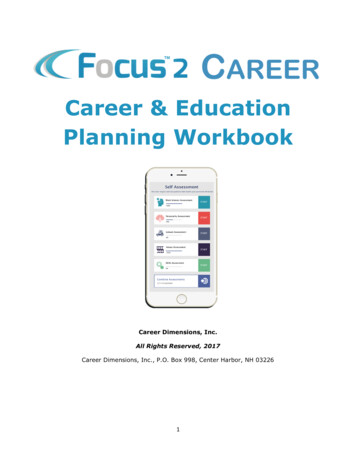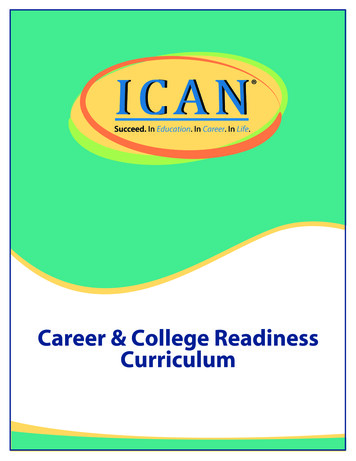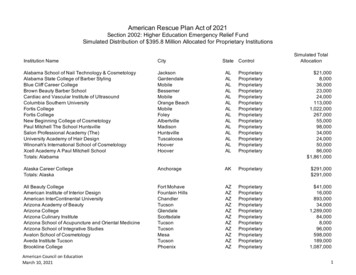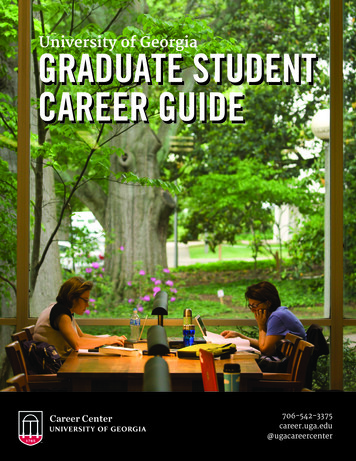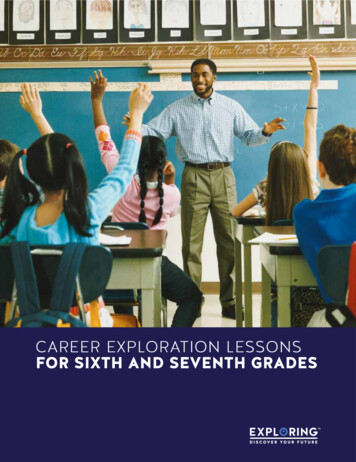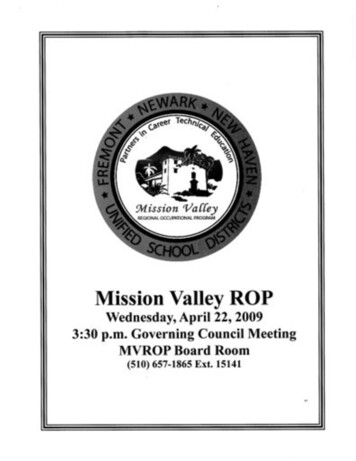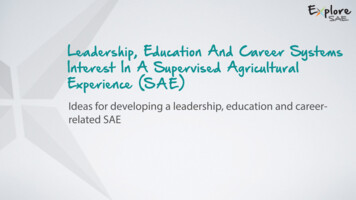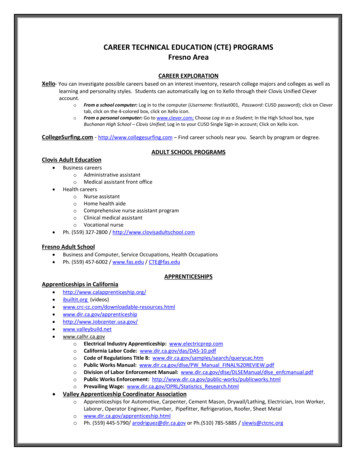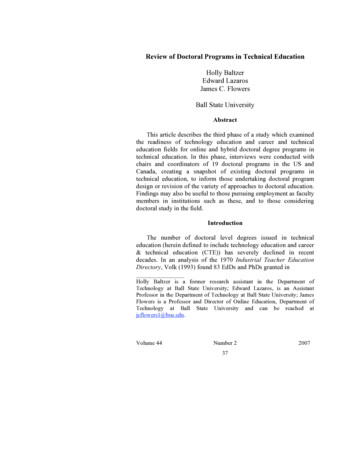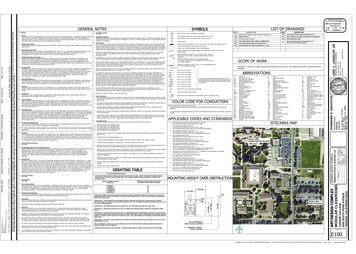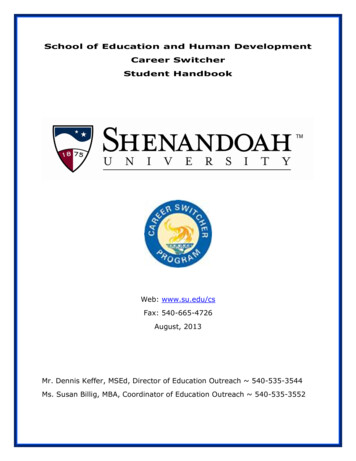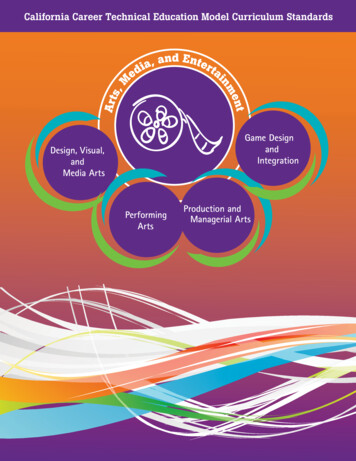
Transcription
,aaiednd Enter tainntmeAr t s,MCalifornia Career Technical Education Model Curriculum StandardsGame DesignandIntegrationDesign, Visual,andMedia ArtsPerformingArtsProduction andManagerial Arts
Table of ContentsArts, Media, and EntertainmentOverview . iiiCalifornia Standards for Career Ready Practice . viSector Description .1Knowledge and Performance Anchor Standards .21.0 Academics . 22.0 Communications. 23.0 Career Planning and Management . 24.0 Technology . 35.0 Problem Solving and Critical Thinking . 36.0 Health and Safety . 37.0 Responsibility and Flexibility . 48.0 Ethics and Legal Responsibilities . 49.0 Leadership and Teamwork. 510.0 Technical Knowledge and Skills . 511.0 Demonstration and Application . 6Pathway Standards .7A. Design, Visual, and Media Arts Pathway. 7B. Performing Arts Pathway . 11C. Production and Managerial Arts Pathway.15D. Game Design and Integration Pathway .17Academic Alignment Matrix .22Contributors .42References . 43ii AME California Career Technical Education Model Curriculum Standards
OverviewThe Career Technical Education (CTE) Model Curriculum Standards publication is organized for useas a complete document or for access to individual industry sectors and pathways. The documentincludes Standards for Career Ready Practice—which describe the knowledge and skills that studentsneed prior to entering a career technical education program—as part of the career technical education sequence or as integrated elements of other course work in preparation for careers and college.Each of the 15 industry sector sections includes a description, anchor standards, pathway standards,and an academic alignment matrix. The standards can be adjusted to be part of the curriculum(grades seven through twelve), provided through adult education, or included in community college programs. The document also lists the representatives who participated in each sector’s contentdevelopment and the references that were consulted to revise the CTE standards.Standards for Career Ready PracticeCalifornia’s Standards for Career Ready Practice, which follow this overview, are based on the CareerReady Practices of the Common Career Technical Core (CCTC), a state-led initiative sponsored by theNational Association of State Directors of Career Technical Education Consortium (NASDCTEc):Career Ready Practices describe the career-ready skills that educators should seekto develop in their students. These practices are not exclusive to a Career Pathway,program of study, discipline or level of education. Career Ready Practices shouldbe taught and reinforced in all career exploration and preparation programs withincreasingly higher levels of complexity and expectation as a student advancesthrough a program of study. (NASDCTEc 2012, 2)California’s 12 Standards for Career Ready Practice align with the state’s CTE anchor standards andreflect the expectations from business and industry, labor and community organizations, and secondary and postsecondary education representatives from 42 participating states.Anchor StandardsThe 11 anchor standards build on the Standards for Career Ready Practice and are common acrossthe 15 industry sectors. Content for these standards was drawn from several documents: “PreparingStudents for the 21st Century Economy” (American Association of Colleges for Teacher Educationand the Partnership for 21st Century Skills 2010); How Should Colleges Prepare Students to Succeedin Today’s Global Economy? (Association of American Colleges and Universities and Peter D. HartResearch Associates, Inc. 2006); “Importance of Skills and Knowledge for College and CareerReadiness,” from The MetLife Survey of the American Teacher: Preparing Students for College andCareers (MetLife, Inc. 2011); and Are They Really Ready to Work? Employers’ Perspectives on the BasicKnowledge and Applied Skills of New Entrants to the 21st Century U.S. Workforce (The ConferenceBoard et al. 2006).Each anchor standard is followed by performance indicators using action verbs from the BeyondKnowledge Construct, presented in a hierarchical progression of simple tasks to more complex tasks.Performance indicators provide guidance for curriculum design and standards measurement.Arts, Media, and Entertainment AME iii
The industry-sector anchor standards have been customized with selected additions to better reflectthe needs and special conditions of each industry sector.Anchor Standard 1 (Academics) guides users to sector-specific core academic standards related toeach industry sector, which are listed in the alignment matrix at the end of each sector section.Anchor standards 2–10 are deliberately aligned with one of the Common Core English language artsstandards, using similar language demonstrating the natural connections between the two subjects.Anchor Standard 11 (Demonstration and Application) highlights classroom, laboratory, and workplacelearning specific to the individual sector and pathways.Pathway StandardsAll 15 industry sectors contain multiple pathways. In order to be identified and listed for an industrysector, each pathway had to meet the following criteria: unique to an industry sector has an occupational focus consistent in size and scope composed of similar functions inclusive of all aspects of the industry includes 8–12 pathway-specific standards demonstrates sequence potential reasonable and appropriate for high school leads to high-skill, high-wage, or high-demand jobs sustainable and viable over the next 10 yearsAcademic Alignment MatrixEach sector includes an academic alignment matrix that displays where a natural, obvious alignmentoccurs. Compiled by five teams of academic content experts in collaboration with industry-sectorconsultants, teachers, and other advisers, the alignment was selected if it was determined that thepathway standard would enhance, reinforce, or provide an application for a specific academic subjectstandard.The alignment matrices include the subjects of Common Core English language arts and mathematics standards, history/social studies standards, and Next Generation Science Core Ideas. To assistwith further review and implementation, each academic alignment is notated with specific pathwaystandards codes.iv AME California Career Technical Education Model Curriculum Standards
ImplementationThe Standards for Career Ready Practice can be integrated with a course or incorporated into severalcourses over multiple school years (grades seven through twelve). The practices are expectationsfor all students, whether they are enrolled in a CTE program or following a more generalized coursesequence. It is expected that all students who exit high school will be proficient in these practices.The anchor standards are the basis for each of the pathways within each sector. These standardsare designed to assist with the development of course curricula and instructional lesson plans; theydescribe what is to be taught and measured. In most cases, the teacher determines the sequence andstrategies to be used to meet the needs of the student population he or she is serving.The performance indicators that follow each standard offer guidance for both course design andstudent assessment. They are intended to guide course work as it is developed. The pathways organizethe standards with a career focus, but they are not designed to be offered as single courses. Rather,the standards from each pathway are collected and organized into a sequence of learning. To meetlocal demands of business and industry and particular student populations, standards can be collectedfrom more than one sector to create a course.Using the academic alignment matrices as a resource, academic and CTE teachers can see whereenhancements and support for both sets of standards can be initiated. CTE teachers can quickly identify academic standards that have a substantial relationship to their instruction. Likewise, academicteachers can specify individual academic standards and quickly identify related CTE standards, whichwill assist them in incorporating application and technology in their curricula and lessons.The CTE Model Curriculum Standards are intended to serve the entire education community—frommiddle schools and high schools to postsecondary colleges and career training programs. A major aimof these standards is to prepare students for postsecondary education and training and to help themmake a smooth transition into the workforce. In order for both the people and the economy of California to prosper, it is essential for all students to emerge from schools ready to pursue their careerand college goals. Equipping all high school students with the knowledge and skills necessary to planand manage their education and careers throughout their lives will help to guarantee these importantoutcomes. Strong CTE programs will continue to provide important educational opportunities to assiststudents as they pursue their dreams and strive for economic prosperity. The CTE Model CurriculumStandards are a resource for educators and the business world for ensuring high-quality CTE learningexperiences and improved student outcomes in the twenty-first-century economy.Arts, Media, and Entertainment AME v
California Standards for CareerReady PracticeStandards for Career Ready Practice describe the fundamental knowledge and skills that a careerready student needs in order to prepare for transition to postsecondary education, career training, orthe workforce. These standards are not exclusive to a career pathway, a CTE program of study, a particular discipline, or level of education. Standards for Career Ready Practice are taught and reinforcedin all career exploration and preparation programs with increasingly higher levels of complexity andexpectation as a student advances through a program of study. Standards for Career Ready Practiceare a valuable resource to CTE and academic teachers designing curricula and lessons in order toteach and reinforce the career-ready aims of the CTE Model Curriculum Standards and the CommonCore State Standards.1. Apply appropriate technical skills and academic knowledge.Career-ready individuals readily access and use the knowledge and skills acquired through experienceand education. They make connections between abstract concepts with real-world applications andrecognize the value of academic preparation for solving problems, communicating with others, calculating measures, and other work-related practices.2. Communicate clearly, effectively, and with reason.Career-ready individuals communicate thoughts, ideas, and action plans with clarity, using written,verbal, electronic, and/or visual methods. They are skilled at interacting with others, are active listeners who speak clearly and with purpose, and are comfortable with the terminology common to theworkplace environment. Career-ready individuals consider the audience for their communication andprepare accordingly to ensure the desired outcome.3. Develop an education and career plan aligned with personal goals.Career-ready individuals take personal ownership of their own educational and career goals and manage their individual plan to attain these goals. They recognize the value of each step in the educational and experiential process and understand that nearly all career paths require ongoing educationand experience to adapt to practices, procedures, and expectations of an ever-changing work environment. They seek counselors, mentors, and other experts to assist in the planning and execution ofeducation and career plans.4. Apply technology to enhance productivity.Career-ready individuals find and maximize the productive value of existing and new technology toaccomplish workplace tasks and solve workplace problems. They are flexible and adaptive in acquiring and using new technology. They understand the inherent risks—personal and organizational—oftechnology applications, and they take actions to prevent or mitigate these risks.vi AME California Career Technical Education Model Curriculum Standards
5. Utilize critical thinking to make sense of problems and persevere in solvingthem.Career-ready individuals recognize problems in the workplace, understand the nature of the problems,and devise effective plans to solve the problems. They thoughtfully investigate the root cause of aproblem prior to introducing solutions. They carefully consider options to solve the problem and, onceagreed upon, follow through to ensure the problem is resolved.6. Practice personal health and understand financial literacy.Career-ready individuals understand the relationship between personal health and workplace performance. They contribute to their personal well-being through a healthy diet, regular exercise, andmental health activities. Career-ready individuals also understand that financial literacy leads to asecure future that enables career success.7. Act as a responsible citizen in the workplace and the community.Career-ready individuals understand the obligations and responsibilities of being a member of a community and demonstrate this understanding every day through their interactions with others. They areaware of the impacts of their decisions on others and the environment around them and think aboutthe short-term and long-term consequences of their actions. They are reliable and consistent in goingbeyond minimum expectations and in participating in activities that serve the greater good.8. Model integrity, ethical leadership, and effective management.Career-ready individuals consistently act in ways that align with personal and community-held idealsand principles. They employ ethical behaviors and actions that positively influence others. They havea clear understanding of integrity and act on this understanding in every decision. They use a varietyof means to positively impact the direction and actions of a team or organization, and they recognizethe short-term and long-term effects that management’s actions and attitudes can have on productivity, morale, and organizational culture.9. Work productively in teams while integrating cultural and global competence.Career-ready individuals positively contribute to every team as both team leaders and team members.They apply an awareness of cultural differences to avoid barriers to productive and positive interaction. They interact effectively and sensitively with all members of the team and find ways to increasethe engagement and contribution of other members.10. Demonstrate creativity and innovation.Career-ready individuals recommend ideas that solve problems in new and different ways and contribute to the improvement of the organization. They consider unconventional ideas and suggestionsby others as solutions to issues, tasks, or problems. They discern which ideas and suggestions mayhave the greatest value. They seek new methods, practices, and ideas from a variety of sources andapply those ideas to their own workplace practices.Arts, Media, and Entertainment AME vii
11. Employ valid and reliable research strategies.Career-ready individuals employ research practices to plan and carry out investigations, create solutions, and keep abreast of the most current findings related to workplace environments and practices.They use a reliable research process to search for new information and confirm the validity of sourceswhen considering the use and adoption of external information or practices.12. Understand the environmental, social, and economic impacts of decisions.Career-ready individuals understand the interrelated nature of their actions and regularly make decisions that positively impact other people, organizations, the workplace, and the environment. Theyare aware of and utilize new technologies, understandings, procedures, and materials and adhere toregulations affecting the nature of their work. They are cognizant of impacts on the social condition,environment, workplace, and profitability of the organization.Note: As stated previously, California’s Standards for Career Ready Practice are based on the CCTC Career ReadyPractices posted at https://careertech.org/ (accessed June 8, 2016).viii AME California Career Technical Education Model Curriculum Standards
Arts, Media, and EntertainmentSector DescriptionOf all the career industries, the Arts, Media, and Entertainment sector requires perhaps the greatest cross-disciplinary interaction because the work in this sector has apropensity to be largely project-based, requiring both independent work and interdependent management skills for career success. New technologies are also constantlyreshaping the boundaries and skill sets of many arts career pathways. Consequently,core arts-sector occupations demand constantly varying combinations of artisticimagination, metaphoric representation, symbolic connections, and technical skills.Successful career preparation involves both broad and in-depth academic and technical preparation as well as the cultivation of twenty-first-century skill assets, suchas flexibility, problem-solving abilities, and interpersonal skills. Careers in the Arts,Media, and Entertainment sector fall into four general pathways: Design, Visual, andMedia Arts; Performing Arts; Production and Managerial Arts; and Game Designand Integration. The anchor and pathway standards make explicit the appropriateknowledge, skills, and practical experience students should have in order to pursuetheir chosen profession, whether that profession requires postsecondary education,graduate training, or apprenticeship.Learning the skills and knowledge for creating, refining, and sharing work in theArts, Media, and Entertainment industry sector promotes teamwork, communication,creative thinking, and decision-making abilities—traits that are necessary to functionsuccessfully in the competitive and media-rich twenty-first century. Through themanipulation of sight, sound, and motion, those choosing a pathway from this sectorreach out in unique ways to enhance the quality of life for those around them.Arts, Media, and Entertainment AME 1
Arts, Media, and EntertainmentKnowledge and Performance Anchor Standards1.0 AcademicsAnalyze and apply appropriate academic standards required for successful industry sector pathwaycompletion leading to postsecondary education and employment. Refer to the Arts, Media, andEntertainment academic alignment matrix for identification of standards.2.0 CommunicationsAcquire and accurately use Arts, Media, and Entertainment sector terminology and protocols at thecareer and college readiness level for communicating effectively in oral, written, and multimediaformats. (Direct alignment with LS 9-10, 11-12.6)2.1Recognize the elements of communication using a sender–receiver model.2.2Identify barriers to accurate and appropriate communication.2.3Interpret verbal and nonverbal communications and respond appropriately.2.4Demonstrate elements of written and electronic communication such as accurate spelling,grammar, and format.2.5Communicate information and ideas effectively to multiple audiences using a variety of mediaand formats.2.6Advocate and practice safe, legal, and responsible use of digital media information andcommunications technologies.3.0 Career Planning and ManagementIntegrate multiple sources of career information from diverse formats to make informed careerdecisions, solve problems, and manage personal career plans. (Direct alignment with SLS 11-12.2)3.1Identify personal interests, aptitudes, information, and skills necessary for informed careerdecision making.3.2Evaluate personal character traits such as trust, respect, and responsibility and understandthe impact they can have on career success.3.3Explore how information and communication technologies are used in career planning anddecision making.3.4Research the scope of career opportunities available and the requirements for education,training, certification, and licensure.3.5Integrate changing employment trends, societal needs, and economic conditions into careerplanning.3.6Recognize the role and function of professional organizations, industry associations, andorganized labor in a productive society.3.7Recognize the importance of small business in the California and global economies.2 AME California Career Technical Education Model Curriculum Standards
3.8Understand how digital media are used by potential employers and postsecondary agenciesto evaluate candidates.3.9Develop a career plan that reflects career interests, pathways, and postsecondary options.4.0 TechnologyUse existing and emerging technology to investigate, research, and produce products and services,including new information, as required in the Arts, Media, and Entertainment sector workplaceenvironment. (Direct alignment with WS 11-12.6)4.1Use electronic reference materials to gather information and produce products and services.4.2Employ Web-based communications responsibly and effectively to explore complex systemsand issues.4.3Use information and communication technologies to synthesize, summarize, compare, andcontrast information from multiple sources.4.4Discern the quality and value of information collected using digital technologies, andrecognize bias and intent of the associated sources.4.5Research past, present, and projected technological advances as they impact a particularpathway.4.6Assess the value of various information and communication technologies to interact withconstituent populations as part of a search of the current literature or in relation tothe information task.5.0 Problem Solving and Critical ThinkingConduct short as well as more sustained research to create alternative solutions to answer aquestion or solve a problem unique to the Arts, Media, and Entertainment sector, using critical andcreative thinking, logical reasoning, analysis, inquiry, and problem-solving techniques. (Direct alignment with WS 11-12.7)5.1Identify and ask significant questions that clarify various points of view to solve problems.5.2Solve predictable and unpredictable work-related problems using various types of reasoning(inductive, deductive) as appropriate.5.3Use systems thinking to analyze how various components interact with each other to produceoutcomes in a complex work environment.5.4Interpret information and draw conclusions, based on the best analysis, to make informeddecisions.6.0 Health and SafetyDemonstrate health and safety procedures, regulations, and personal health practices and determinethe meaning of symbols, key terms, and domain-specific words and phrases as related to the Arts,Media, and Entertainment sector workplace environment. (Direct alignment with RSTS 9-10, 11-12.4)6.1Locate, and adhere to, Material Safety Data Sheet (MSDS) instructions.Arts, Media, and Entertainment AME 3
6.2Interpret policies, procedures, and regulations for the workplace environment, includingemployer and employee responsibilities.6.3Use health and safety practices for storing, cleaning, and maintaining tools, equipment,and supplies.6.4Practice personal safety when lifting, bending, or moving equipment and supplies.6.5Demonstrate how to prevent and respond to work-related accidents or injuries; this includesdemonstrating an understanding of ergonomics.6.6Maintain a safe and healthful working environment.6.7Be informed of laws/acts pertaining to the Occupational Safety and Health Administration(OSHA).7.0 Responsibility and FlexibilityInitiate, and participate in, a range of collaborations demonstrating behaviors that reflect personaland professional responsibility, flexibility, and respect in the Arts, Media, and Entertainment sectorworkplace environment and community settings. (Direct alignment with SLS 9-10, 11-12.1)7.1Recognize how financial management impacts the economy, workforce, and community.7.2Explain the importance of accountability and responsibility in fulfilling personal, community,and workplace roles.7.3Understand the need to adapt to changing and varied roles and responsibilities.7.4Practice time management and efficiency to fulfill responsibilities.7.5Apply high-quality techniques to product or presentation design and development.7.6Demonstrate knowledge and practice of responsible financial management.7.7Demonstrate the qualities and behaviors that constitute a positive and professional workdemeanor, including appropriate attire for the profession.7.8Explore issues of global significance and document the impact on the Arts, Media, andEntertainment sector.8.0 Ethics and Legal ResponsibilitiesPractice professional, ethical, and legal behavior, responding thoughtfully to diverse perspectives andresolving contradictions when possible, consistent with applicable laws, regulations, and organizational norms. (Direct alignment with SLS 11-12.1d)8.1Access, analyze, and implement quality assurance standards of practice.8.2Identify local, district, state, and federal regulatory agencies, entities, laws, and regulationsrelated to the Arts, Media, and Entertainment industry sector.8.3Demonstrate ethical and legal practices consistent with Arts, Media, and Entertainmentsector workplace standards.8.4Explain the importance of personal integrity, confidentiality, and ethical behavior in theworkplace.4 AME California Career Technical Education Model Curriculum Standards
8.5Analyze organizational culture and practices within the workplace environment.8.6Adhere to copyright and intellectual property laws and regulations, and use and appropriatelycite proprietary information.8.7Conform to rules and regulations regarding sharing of confidential information, as determinedby Arts, Media, and Entertainment sector laws and practices.9.0 Leadership and TeamworkWork with peers to promote divergent and creative perspectives, effective leadership, groupdynamics, team and individual decision making, benefits of workforce diversity, and conflict resolution as practiced in the SkillsUSA career technical student organizations. (Direct alignment with SLS11-12.1b)9.1Define leadership and identify the responsibilities, competencies, and behaviors of successfulleaders.9.2Identify the characteristics of successful teams, including leadership, cooperation, collaboration, and effective decision-making skills as applied in groups, teams, and career technicalstudent organization activities.9.3Understand the characteristics and benefits of teamwork, leadership, and citizenship in theschool, community, and workplace setting.9.4Explain how professional associations and organizations and associated leadership development and competitive career development activities enhance academic preparation, promotecareer choices, and contribute to employment opportunities.9.5Understand that the modern world is an international community and requires an expandedglobal view.9.6Respect individual and cultural differences and recognize the importance of diversity in theworkplace.9.7Participate in interactive teamwork to solve real Arts, Media, and Entertainment sector issuesand problems.10.0 Technical Knowledge and SkillsApply essential technical knowledge and skills common to all pathways in the Arts, Media, andEntertainment sector, following procedures when carrying out experiments or performing technicaltasks. (Direct alignment with WS 11-12.6)10.1 Interpret and explain terminology and practices specific to the Arts, Media, and Entertainment sector.10.2 Comply with the rules, regulations, and expectations of all aspects of the Arts, Media, andEntertainment sect
Media Arts Performing Arts Production and Managerial Arts Game Design and Integration. Table of Contents Arts, Media, and Entertainment . . ics standards, history/social studies standards, and Next Generation Science Core Ideas. To assist with further review and implementation, ea
